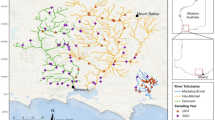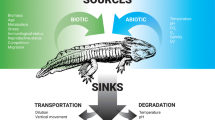Abstract
There is a pressing need to obtain historical information on estuaries so that levels of natural variability and ecosystem thresholds can be identified. Once these factors are known, estuaries that exhibit high conservation value and minimal impact from anthropogenic activity can be acknowledged and protected. In order to understand and quantify the level of change that may have occurred due to human impact, near pristine estuaries that have the potential to act as reference sites need to be identified. However, this is often difficult due to a lack of documented knowledge of estuary variability. This paper retrospectively assesses environmental conditions in the Burrum River, a sub-tropical east Australian estuary on the coast of Queensland, using diatom and stable isotope analyses. These techniques were combined with AMS 14C dating methods to determine if this system has undergone any natural or anthropogenically induced change. Diatom assemblages have shown very little variation over the past 5,000 years, indicating minimal changes to water quality. Upper and lower limits for δ13C and δ15N stable isotope results also infer that the sources of carbon and nitrogen to the Burrum River estuary have remained constant over this time period. Carbon inputs have been dominated by marine autotrophic production, whilst nitrogen inputs are indicative of terrestrial sources. Hence, the Burrum River has not been altered by anthropogenic activities and is a suitable reference site for benchmarking impacted sub-tropical estuaries. This paper demonstrates that paleolimnological techniques can be applied successfully to identify estuaries that are suitable as reference sites.





Similar content being viewed by others
References
Anderson NJ (1993) Natural versus anthropogenic change in lakes: the role of the sediment record. Trends Ecol Evol 8:356–361
Bengtsson L, Enell M (1986) Chemical analysis. In: Berglund BE (ed) Handbook of Holocene paleoecology and paleoydrology. Wiley, NJ, pp 423–449
Bennion H, Battarbee R (2007) The European Union Water Framework Directive: opportunities for paleolimnology. J Paleolimnol 38:285–295
Bennion H, Fluin J, Simpson GL (2004) Assessing eutrophication and reference conditions for Scottish freshwater lochs using subfossil diatoms. J Appl Ecol 41:134–138
Candy I (2009) Terrestrial and freshwater carbonates in Hoxnian interglacial deposits, UK: micromorphology, stable isotopic composition and paleoenvironmental significance. Proc Geol Assoc 120:49–57
Colman SM, Baucom PC, Bratton JF, Cronin TM, McGeehin JP, Willard D, Zimmerman AR, Vogt PR (2002) Radiocarbon dating, chronologic framework, and change in accumulation rates of Holocene estuarine sediments from Chesapeake Bay. Quatern Res 57:58–70
Cooper SR, Brush GS (1993) A 2500-year history of anoxia and eutrophication in Chesapeake Bay. Estuaries 16:617–626
Dolbeth M, Cardoso PG, Ferreira SM, Verdelhos T, Raffaelli R, Pardal MA (2007) Anthropogenic and natural disturbance effects on a macrobenthic estuarine community over a 10-year period. Mar Pollut Bull 54:576–585
Eyre BD (1997) Water quality changes in an episodically flushed sub-tropical Australian estuary: a 50 year perspective. Mar Chem 59:177–187
Foged N (1978) Diatoms in Eastern Australia. Bibliotheca Phycologica 41:1–243
Gell PA, Sonneman JA, Reid MA, Illman MA, Sincock AJ (1999) An illustrated key to the common diatom genera from southern Australia—identification Guide No. 26. Cooperative Research Centre for Freshwater Ecology
Harrison J, Heijnis H, Caprarelli G (2002) Historical pollution variability from abandoned mine sites, greater blue mountains world heritage area, New South Wales, Australia. Environ Geol 43:680–687
He Q, Walling DE (1996) Interpreting particle size effects in the adsorption of 137Cs and unsupported 210Pb by mineral soils and sediments. J Environ Radioact 30:117–137
Juggins S (2007) C2 version 1.5: software for ecological and paleoecological data analysis and visualisation. University of Newcastle, Newcastle upon Tyne
Lindeboom H (2002) The coastal zone: an ecosystem under pressure. In: Field JG, Hempel G, Summerhayes C (eds) Oceans 2020: science, trends and the challenge of sustainability. Island Press, Washington, pp 49–84
Logan B, Taffs K, Cunningham L (2010) Applying paleolimnological techniques in estuaries: a cautionary tale from Moreton Bay, Australia. Mar Freshw Res 61:1039–1047
Logan B, Taffs K, Eyre B, Zawadzki A (in press) Assessing changes in nutrient status in the Richmond River estuary, Australia, using paleolimnological methods. J Paleolimnol. doi:10.1007/s10933-010-9457-x
Logan B, Taffs KH (submitted) Relationships between diatoms and water quality in sub-tropical east-Australian estuaries. J Paleolimnol
Loneragan NR, Bunn SE (1999) River flows and estuarine ecosystems: implications for the coastal fisheries from a review and a case study of the Logan River, southeast Queensland. Aust J Ecol 24:431–440
Maslin MA, Swann GEA (2006) Isotopes in marine sediments. In: Leng MJ (ed) Isotopes in paleoenvironmental research. Springer, The Netherland, pp 227–290
McClelland JW, Valiela I, Michener RH (1997) Nitrogen-stable isotope signatures in estuarine food webs: a record of urbanization in coastal wetlands. Limnol Oceanogr 52:930–937
McCormac FG, Hogg AG, Blackwell PG, Buck CE, Higham TFG, Reimer PJ (2004) Shcal04 Southern hemisphere calibration, 0–11.0 cal kyr bp. Radiocarbon 46:1087–1092
McMahon K, Bengston Nash S, Eaglesham G, Muller JF, Duke NC, Winderlich S (2005) Herbicide contamination and the potential impact to seagrass meadows in Hervey Bay, Queensland, Australia. Mar Pollut Bull 51:325–334
Middelburg JJ, Nieuwenhuise J (1998) Carbon and nitrogen stable isotopes in suspended matter and sediments from the Schelde Estuary. Mar Chem 60:217–225
OzCoasts (2009) Australian online coastal information [www.ozcoasts.org.au] Retrieved 30 June 2009
Parr JF, Taffs KH, Lane CM (2004) A microwave digestion technique for the extraction of fossil diatoms from coastal lake and swamp sediments. J Paleolimnol 31:383–390
Rasanen J, Kauppila T, Salonen V (2006) Sediment-based investigation of naturally or historically eutrophic lakes—implications for management. J Environ Manage 79:253–265
Reavie ED, Hall RI, Smol JP (1995) An expanded weighted-averaging model for inferring past total phosphorus concentrations from diatom assemblages in eutrophic British Columbia (Canada) lakes. J Paleolimnol 14:49–67
Ribbe J (2006) A study into the export of saline water from Hervey Bay, Australia. Estuar Coast Shelf Sci 66:550–558
Rosen P, Hall R, Korsman T, Renberg I (2000) Diatom transfer-functions for quantifying past air temperature, pH and total organic carbon concentration from lakes in northern Sweden. J Paleolimnol 24:109–123
Saunders KM (in press) Development of diatom-based inference models for assessing coastal water quality, natural variability and human impacts in southeast mainland Australia and Tasmania. J Paleolimnol. doi:10.1007/S10983-010-9456-y
Saunders KM, Taffs KH (2009) Paleoecology: a tool to improve the management of estuaries. J Environ Manag 90:2730–2736
Smith SDA, Rule MJ, Harrison M, Dalton SJ (2008) Monitoring the sea change: preliminary assessment of the conservation value of nearshore reefs, and existing impacts in a high-growth, coastal region of sub-tropical eastern Australia. Mar Pollut Bull 56:525–534
Smol JP (1992) Paleolimnology: an important tool for effective ecosystem management. J Aquat Ecosys Heal 1:49–58
Stuiver M, Reimer PJ (1993) Extended 14C database and revised CALIB radiocarbon calibration program. Radiocarbon 35:215–230
Taffs K (2005) Diatoms of Northern New South Wales, Australia. Unpublished dataset. Southern Cross University, Australia
Talbot MR (2001) Nitrogen isotopes in paleolimnology. In: Last WM, Smol JP (eds) Tracking environmental change using lake sediments, vol 2: physical and geochemical methods. Kluwer Academic Publishers, Dordrecht, pp 401–439
Thoms MC, Ogden RW, Reid MA (1999) Establishing the condition of lowland floodplain rivers: a paleo-ecological approach. Freshw Biol 41:407–423
Tibby J, Reid MA (2004) A model for inferring past conductivity in low salinity waters derived from Murray River (Australia) diatom plankton. Mar Freshw Res 55:597–607
Vaalgaama S (2004) The effect of urbanisation on Laajalahti Bay, Helsinki City, as reflected by sediment geochemistry. Mar Pollut Bull 48:650–662
Valiela I, Foreman K, LaMontagne M, Hersh D, Costa J, D’Avanzo C, Babione M, Peckol P, Demeo-Anderson B, Sham C, Brawley J, Lajtha K (1992) Couplings of watersheds and coastal waters: sources and consequences of nutrient enrichment in Waquoit Bay, Massachusetts. Estuaries 15:443–457
Weckström K (2006) Assessing recent eutrophication in coastal waters of the Gulf of Finland (Baltic Sea) using subfossil diatoms. J Paleolimnol 35:571–592
Witkowski A, Lange-Bertelot H, Metzeltin S (2000) Diatom flora of marine coasts 1. In: Lange-Bertelot H (ed) Iconographia Diatomologica, vol 7. Koeltz Scientific Books, Germany
Wolanski E (2007) Estuarine ecohydrology. Elsevier, The Netherlands
Yang J, Basu BK, Hamilton PB, Pick FR (1997) The development of a true riverine phytoplankton assemblage along a lake-fed lowland river. Archiv fuer Hydrobiologie 140:243–260
Acknowledgments
We thank Steve Logan, Rod Latimer, Ben Andrews and Peter O’Neill for their assistance with field work; Bradley Eyre and Melissa Bautista for assistance with stable isotope analyses; Geraldine Jacobsen for assistance with 14C analyses, and Atun Zawadski for 210Pb analyses; Brad Pillans for his help with the paleomagnetic analysis; Damien Maher and Dirk Erler for their comments on the manuscript; Neville Minch for his work on the figures.
Author information
Authors and Affiliations
Corresponding author
Rights and permissions
About this article
Cite this article
Logan, B., Taffs, K.H. The Burrum River estuary: identifying reference sites for Australian sub-tropical estuarine systems using paleolimnological methods. J Paleolimnol 46, 613–622 (2011). https://doi.org/10.1007/s10933-010-9480-y
Received:
Accepted:
Published:
Issue Date:
DOI: https://doi.org/10.1007/s10933-010-9480-y




